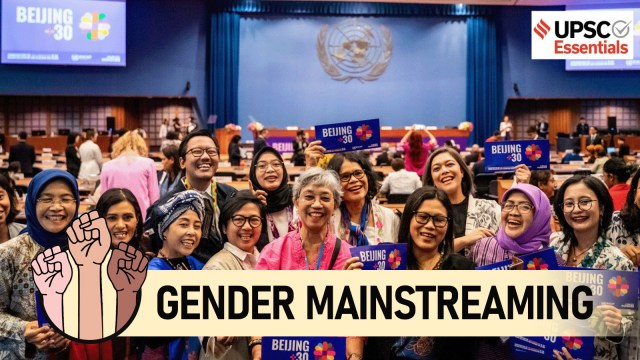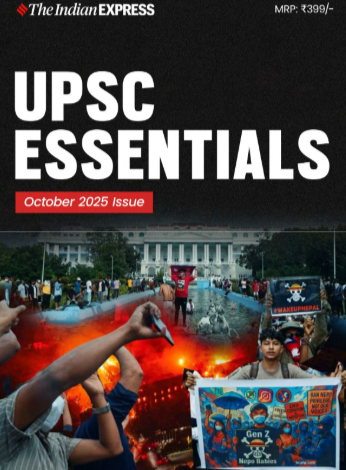© IE Online Media Services Pvt Ltd
Latest Comment
Post Comment
Read Comments
 The Asia-Pacific Ministerial Conference on the Beijing+30 Review from 19 to 21 November 2024 at the UN Conference Centre in Bangkok, Thailand. Photo: UN Women/Ploy Phutpheng
The Asia-Pacific Ministerial Conference on the Beijing+30 Review from 19 to 21 November 2024 at the UN Conference Centre in Bangkok, Thailand. Photo: UN Women/Ploy Phutpheng— Amina Hussain
(The Indian Express has launched a new series of articles for UPSC aspirants written by seasoned writers and scholars on issues and concepts spanning History, Polity, International Relations, Art, Culture and Heritage, Environment, Geography, Science and Technology, and so on. Read and reflect with subject experts and boost your chance of cracking the much-coveted UPSC CSE. In the following article, gender expert Amina Hussain analyses how the Beijing Declaration reinvigorated grassroots-level activism towards women empowerment.)
“Over the past three decades, this framework (the Beijing Declaration and Platform for Action) has not only shaped national policies but has also inspired legal reforms and guided efforts at the global, regional, and national levels toward advancing gender equality,” said UN Under-Secretary-General Armida Salsiah Alisjahbana.
“But as we celebrate, we must confront a sobering reality that not all news is good. In many areas, progress has been uneven and, in some cases, fragile,” she told PTI in an interview on the sidelines of the UN Ministerial Conference in Bangkok last month ahead of next year’s 30th anniversary of the Beijing Declaration and Platform for Action.
The Beijing Declaration and Platform for Action remains a foundational and progressive document on gender equality. However, despite 30 years of its unanimous and resounding consensus, its effective implementation remains a struggle for nations worldwide.
The Beijing Declaration was just as revolutionary as decades-long women’s efforts to redefine the narrative on women’s rights as fundamental human rights. More than anything, it created a revolutionary spirit and reinvigorated grassroots-level activism. The declaration advocated a multidimensional and multisectoral approach to addressing women’s issues and moved beyond economic and social rights emphasised in earlier conferences.
It also included poverty, education and training, health, violence against women, armed conflict, economy, power and decision-making, institutional mechanisms for advancement, human rights, media and the environment, and put a special emphasis on the girl child, facilitating gender mainstreaming across all levels of governance, management, policies and programmes.
One of the most significant achievements of the Beijing Conference was the active role and participation of civil society and grassroots organisations, which were instrumental in shaping its agenda and outcomes.
Story continues below this ad
Unlike the state-centric approach of previous conferences, Beijing allowed for a more inclusive, integrated, and participatory approach. This became possible due to a parallel conference of NGO Forum on Women at Huairou, a small town on the outskirts of Beijing.
The forum provided an international platform for NGOs, grassroots activists, indigenous women, and local women’s groups to share their experiences, needs, strategies, resources and networks as part of the global agenda for women’s rights. It culminated in the adoption of the ‘Beijing Declaration of the Indigenous Women’ signed at the Indigenous Women’s Tent in 1995 in Huairou. This declaration highlighted the challenges faced by indigenous communities and their demand for self-determination.
One of the demands was to add an “s” in indigenous “peoples” in all documentations, declarations and conventions: “Hereafter, we will not be referred to as ethnic minorities or cultural communities but as Indigenous peoples”. It was a significant move towards reclaiming identity within the postcolonial discourse of the ‘New World Order’.
Although the NGO Forum at Huairou was groundbreaking, it faced logistical challenges and conflicts arising out of dissenting views and security concerns over freedom of speech and protest. Despite this, it marked a paradigm shift as it attracted more than 50,000 participants from all over the world with the sole objective of amplifying the voices of women from the Global South. The forum allowed grassroots perspective to inform international policy discussions within the United Nations.
Unlike the government-sponsored delegation of women at the United Nations designated conference, women at the NGO forum came on their own, at their own expense, questioning official and state narratives. For instance, Tanya Nathan in an article titled Perspective on the NGO Forum on Women – Huairou, China, 1995 noted, “A group of Iranian refugees living in Sweden gave testimonials, documented with photos, of terrible oppression of women in Iran, including execution for improper clothing.”
But the “government delegation from Iran berated these women, calling them liars and claiming that conditions for women in Iran were quite good,” added the author.
Huairou provided an alternate space for women to share their lived experiences, where their identity as women transcended barriers of race, class, country, region, language and ethnicity.
The forum offered a range of workshops that redefined the nature of women’s conferences. The nearly 200-page-long conference programme featured more than 127 regional workshops, exhibits, panels and plenaries on local issues such as advocacy training for women leaders, breaking silence on Algerian women, women’s health in Zimbabwe, combating trafficking of women in Asia, access to healthy water, media, microcrediting, and environmental racism. Plenaries on issues like “outlaw poverty, not prostitution”, captured the global dynamics of women’s struggles.
Regional tents facilitated participatory activities symbolising women as a collective and a creative force, like making an international peace quilt at the peace tent or singing Indian women’s labour songs in the Indian regional tent. Women shared stories and experiences of fear and courage, sang songs, translated for each other, fostering solidarity and breaking formal hierarchies. The transformative power of the indigenous women’s networking catalysed international solidarity, proclaiming that they are not passive beneficiaries but active agents of change in women’s rights struggle.
The Beijing conference inspired waves of grassroots feminist initiatives all over the world and had a significant influence in India. It played a vital role in inspiring various government initiatives like the National Policy for the Empowerment of Women (2001), Domestic Violence Act (2005), and POSH (Prevention, Prohibition and Redressal) Act (2013). Additionally, flagship government programmes like ‘Beti Bachao Beti Padhao’ (2015), Pradhan Mantri Ujjwala Yojana (2016), Swachh Bharat Mission, and Rashtriya Mahila Kosh address women-specific needs and empowerment.
The formation of SGH (Self Help Groups) helped empower women by fostering financial independence. However, the effective execution of these initiatives on ground remains a daunting task. Crime against women and gender disparities in education persist despite higher enrollment rates for girls, while women’s participation in the labour force is among the lowest globally, standing at just 32.7 per cent in 2022-2023.
India also slipped to the 129th position in the Global Gender Gap Report 2023 released by the World Economic Forum. It ranked 65th in political empowerment. In economic parity, it scored 39.8 per cent at 142nd position. These issues underscore the ongoing battle for gender equality in India.
Moreover, the rapidly changing world has brought new forms of gender inequity. The climate crisis disproportionately affects women, especially the tribal and Adivasi women. The expanding internet revolution and emerging AI technologies have yet to ensure a safe digital space for women. Women with disabilities face greater risk of violence exacerbated by lack of access to support services and social stigma. They are often excluded and marginalised within the disability rights movement and feminist advocacy.
Moving forward, the battle of gender rights needs to move beyond traditional binaries, and be more inclusive to embrace gender diversity and different sexual identities. Most importantly, men should be an integral part of this dialogue to foster systemic change.
In what ways did the Beijing Declaration create a revolutionary spirit and reinvigorate grassroots-level activism?
What was the significance of the multidimensional and multisectoral approach advocated by the Beijing Declaration in addressing women’s issues?
What are the primary challenges in effectively implementing gender equality initiatives in India?
How does the persistence of crimes against women highlight the challenges in achieving gender equality in India?
What measures are necessary to address the gap between policy initiatives and ground-level execution in promoting gender equality?
(Dr. Amina Hussain is an Assistant Professor at Sarojini Naidu Centre for Women’s Studies, Jamia Millia Islamia University.)
Share your thoughts and ideas on UPSC Special articles with ashiya.parveen@indianexpress.com.
Subscribe to our UPSC newsletter and stay updated with the news cues from the past week.
Stay updated with the latest UPSC articles by joining our Telegram channel – IndianExpress UPSC Hub, and follow us on Instagram and X.

Read UPSC Magazine




